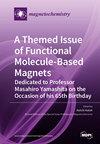Ba2ScRuO6的磁性和交换偏压特性
IF 2.5
4区 化学
Q2 CHEMISTRY, INORGANIC & NUCLEAR
引用次数: 1
摘要
本文介绍了在环境压力下合成的多晶Ba2ScRuO6的结构、详细的磁性和交换偏压研究。与锶类似物相比,这种材料结晶为6L六方结构,空间群为P3’m1。使用室温粉末XRD图谱的Rietveld细化表明结构中存在Ru-Sc无序。直流电阻率的温度变化突出了电子传导的半导体行为,对应于莫特的3D可变范围跳跃(VRH)模型。详细的磁化测量表明,Ba2ScRuO6在TN≈9k时形成反铁磁有序。有趣的是,在9k(TN)以下,磁化曲线的场冷却磁场变化(FC)突出了样品中的交换偏置效应。在2K时,交换偏置场达到1.24kOe的最大值。低于磁有序温度的交换偏置效应可归因于由于结构中的无序而导致的不均匀磁相关性。值得注意的是,在Ba2ScRuO6中出现大的交换偏置场表明,非均匀六方双钙钛矿是一类有希望探索在自旋电子学中具有潜在应用的新材料。本文章由计算机程序翻译,如有差异,请以英文原文为准。
Magnetism and Exchange Bias Properties in Ba2ScRuO6
This paper presents structural, detailed magnetic, and exchange bias studies in polycrystalline Ba2ScRuO6 synthesized at ambient pressure. In contrast to its strontium analogue, this material crystallizes in a 6L hexagonal structure with space group P3¯m1. The Rietveld refinement using the room-temperature powder XRD pattern suggests a Ru-Sc disorder in the structure. The temperature variation of the DC electrical resistivity highlights a semiconducting behavior with the electron conduction corresponding to Mott’s 3D variable range hopping (VRH) model. The detailed magnetization measurements show that Ba2ScRuO6 develops antiferromagnetic ordering at TN≈ 9 K. Interestingly, below 9 K (TN), the field-cooled magnetic field variation (FC) of the magnetization curves highlights an exchange bias effect in the sample. The exchange bias field reaches a maximum value of 1.24 kOe at 2 K. The exchange bias effect below the magnetic ordering temperature can be attributed to the inhomogeneous magnetic correlations due to the disorder in the structure. Remarkably, the appearance of a large exchange bias field in Ba2ScRuO6 indicates that inhomogeneous hexagonal double perovskites are a promising class to explore new materials having potential applications in spintronics.
求助全文
通过发布文献求助,成功后即可免费获取论文全文。
去求助
来源期刊

Magnetochemistry
Chemistry-Chemistry (miscellaneous)
CiteScore
3.90
自引率
11.10%
发文量
145
审稿时长
11 weeks
期刊介绍:
Magnetochemistry (ISSN 2312-7481) is a unique international, scientific open access journal on molecular magnetism, the relationship between chemical structure and magnetism and magnetic materials. Magnetochemistry publishes research articles, short communications and reviews. Our aim is to encourage scientists to publish their experimental and theoretical results in as much detail as possible. Therefore, there is no restriction on the length of the papers. The full experimental details must be provided so that the results can be reproduced.
 求助内容:
求助内容: 应助结果提醒方式:
应助结果提醒方式:


